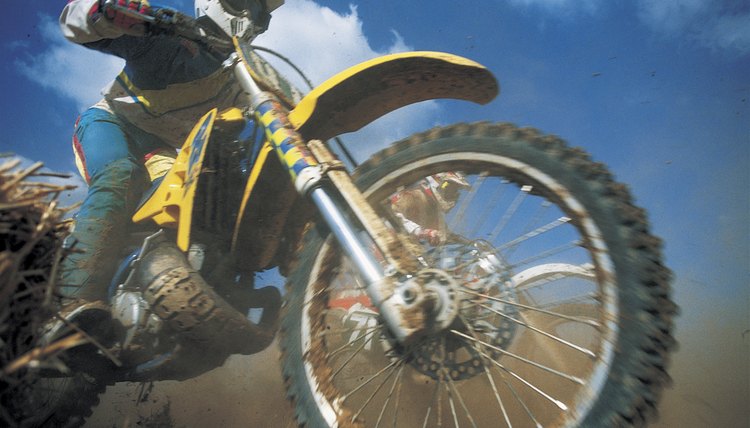The Average Speed of a Pit Bike

Those who attend pit bike races are likely to overhear chatter about which bike or rider was faster in a section of the course. Pit bikes compete in classes based on engine size. Depending on the course or type of event, rider-mechanics might set up a bike for low-end acceleration or top speed. Like all dirt bikes, the average speed of a pit bike varies with the size of the engine and the gearing.
Engine Sizes
Standard pit bikes engines range from 50 cc to 140 cc. Some manufacturers produce versions with 175- and 250-cc engines, but these exceed the mini-moto class that typifies pit bikes. In keeping with typical dirt bike riding, pit bikes are engineered to reach maximum rpm quickly in each gear. On short sections in lower gears, top speed might range from 15 to 25 miles per hour with a 50-cc bike. On longer sections, the bike can reach top speed in the range of 50 mph. Larger 140-cc pit bikes with stock sprocket gearing are capable of a 70-mph top speed in high gear.
Sprocket Gearing
The smaller drive sprocket and the larger rear sprocket on a pit bike produce a base gear ratio. Manufactures are known to target a wider consumer base by setting up pit bikes with a sprocket combination that provides overall performance. A standard sprocket setup is typically 14/42, with a 14-tooth drive sprocket and a 42-tooth rear sprocket. Using the engine rpm red line as a benchmark, the average speed of a 50-cc pit bike ranges between 22 and 25 mph. This is based on 15-mph top speed in first gear and the 50-mph top speed in fourth gear. Applying a similar red-line benchmark to 140-cc bikes, the average speed is around 35 mph.
Modifications
If you wanted to increase the average speed of a pit bike without compromising low-end torque acceleration, you would replace one of the stock sprockets. Changing the stock 14-tooth drive sprocket to a 15-tooth sprocket adds top speed. Replacing the stock 42-tooth rear sprocket with a smaller 32-tooth sprocket adds speed but affects low-end torque acceleration. Most 50-cc race mechanics would consider a gain of 3 mph average speed exceptional. Adding 5 mph to the 140-cc average of 35 mph might be the difference between finishing near the front or running the middle of the field. Understanding sprocket gearing allows you to increase average speed without compromising torque acceleration that’s necessary to attain top speeds quickly on dirt bikes.
Time Trials
To accurately determine the average speed of a particular pit bike, define a course of a specific distance and enlist a novice rider, an expert rider and a timekeeper. Have each rider take three laps on the course to provide your averaging data. With a stock bike, your data will most likely correlate with calculations based on engine size and sprocket gearing. At the end of the day, you might conclude that the average speed of a pit bike is relative to a rider’s level of expertise. With regard to rider’s safety, the slower average speed of pit bikes compared with larger dirt bikes could be interpreted as deliberate on the part of manufacturers. A concerned adult might have reservations about seating a young rider on a pit bike that’s capable of faster average speed and top speed.
Writer Bio
William Machin began work in construction at the age of 15, while still in high school. In 35 years, he's gained expertise in all phases of residential construction, retrofit and remodeling. His hobbies include horses, motorcycles, road racing and sport fishing. He studied architecture at Taft Junior College.
